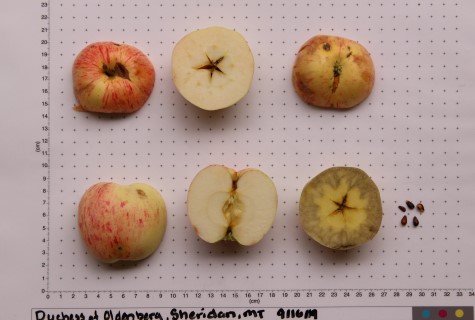Duchess of Oldenburg
Fruit Description Duchess of Oldenburg
Size: Medium to large.
Shape: Flat, flat-round, round or oblong. Irregular, sometimes ribbed or angular, especially at apex
Skin: Pale green, yellow-green or yellow ground color. Broad, broken splashes of red, pink red, carmine or scarlet stripes increasing with exposure to sunlight. Occasional russet mostly in cavity. Can be waxy.
Stalk (stem) and Cavity: Stem usually protrudes but not always, variable length typcially medium and slender. Cavity acute.
Basin: Deep, wide, abrupt.
Calyx (Eye): Closed.
Core (Vertical): Calyx tube conical or funnel shaped long. Core line basal clasping to median. Carpels ovate. Stamens median.
Carpels and Axial Sac (Transverse): Carpels pubescent, variable, axile open or closed. narrow to medium in width.
Seeds: Dark, large, obtuse or acute points. Often plump.
Flesh: Cream to yellow, crisp, tender and juicy. Becomes mealy if left on tree too long.
Flavor: Sub-acid aromatic.
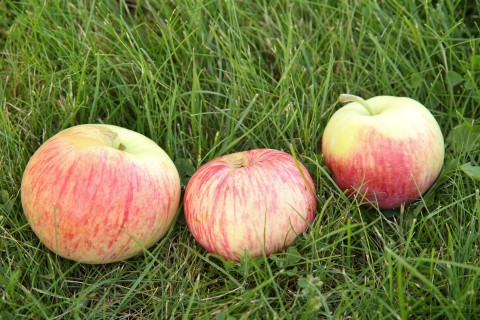
Additional Notes
Synonyms: 'Borovinka', 'Borowitsky', 'Oldenburg', 'Duchess', 'Charlamoff', 'Charlamofsky', 'Queen Mary', 'Smith's Beauty of Newark', and possibly 70 more.
First Recorded: 1700s, brought to U.S. by Massachusetts Horticultural Society in 1835
Origin: Tula region of Russia
Bloom time: Mid
Harvest: Early to Mid
Use: Sauce and fresh eating.
Storage: Poor
Disease: Susceptible to fire blight, resistant to scab.
Tree: Very hardy, vigorous, consistent bearer, medium size, suggested as a filler in orchards.
Parentage: Unknown
Frequency in Montana Orchards based on DNA testing: Medium
Lookalikes: 'Wealthy'
History
'Duchess of Oldenburg' was one of four Russian apples imported in 1835 by the Massachusetts Horticultural Society for use by pioneers settling in northern climates. It's original name and origins are unknown, but it is believed to be the same apple referred to in Russia as 'Borovinka' or 'Borowitsky', renamed to honor Emperor Alexander's sister, Grand Duchess Catherine Plavnova, wife of Duke George of Oldenburg.
The apple quickly became an important apple in America due to its cold hardiness and was popular on homesteads across the west and is still widely available. While the date of introduction in Montana is unkown' it was noted as bearing in 1878 at the Pine Grove Farm in Stevensville, MT, one of Montana's first commercial orchards.
Additional Photos

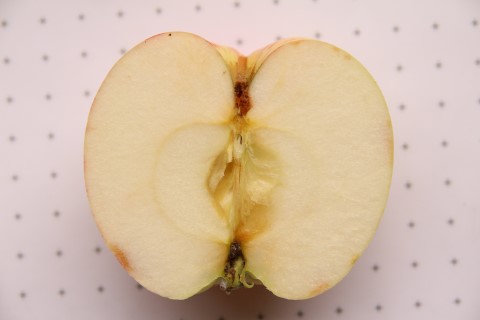

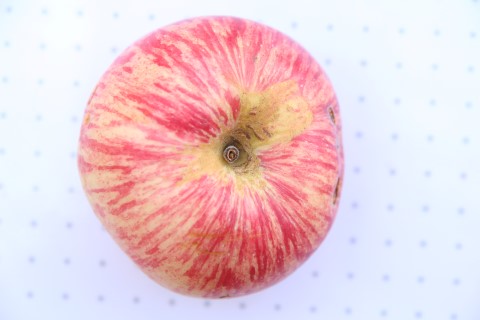
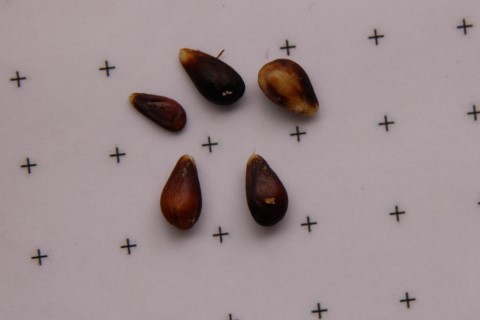
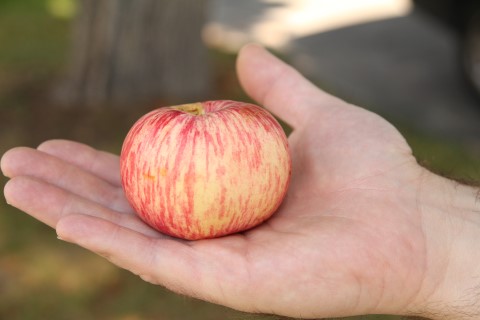
References
Applename.com, 'Duchess of Oldenburg'. Viewed online February 11, 2021. http://www.applename.com/varieties/duchess-of-oldenburg.
Bunker, J. (2019). Apples and the Art of Detection.
FruitID.com, "Duchess of Oldenburg". Viewed online February, 11, 2021. https://www.fruitid.com/#view/445.
Hedrick, U. P. (1922). Cyclopedia of hardy fruits. New York: The Macmillan company.
Pomiferous, "Duchess of Oldenburg". Viewed online February 15, 2021. https://pomiferous.com/applebyname/duchess-of-oldenburg-id-2452
Rocky Mountain husbandman. [volume] (Diamond City, Mont.), 25 April 1878. Chronicling America: Historic American Newspapers. Lib. of Congress. https://chroniclingamerica.loc.gov/lccn/sn83025309/1878-04-25/ed-1/seq-1/
Volk, G. M., & Henk, A. D. (2016). Historic American Apple Cultivars: Identification and Availability, Journal of the American Society for Horticultural Science J. Amer. Soc. Hort. Sci., 141(3), 292-301. Retrieved Feb 15, 2021, from https://journals.ashs.org/jashs/view/journals/jashs/141/3/article-p292.xml

